NOTE: For prior parts in The Archivist series you can view an archive of it all here. And for his older series see: Musings of an Iraqi Brasenostril on Jihad.
—
The Islamic State’s Security Apparatus Structure in the Provinces
By Aymenn al-Tamimi
Introduction
Like any state-like governance project, it is hardly surprising that the Islamic State (IS) should have bureaucracy dedicated to the maintenance of internal security in the territories under its control. This field of responsibility falls broadly under the Diwan al-Amn al-Aam (Public Security Department), one of a series of diwans set up by IS in the wake of its Caliphate declaration in June 2014. Little, however, has come to light regarding the internal structure of IS’ security apparatus. The exclusive IS documents discussed in this piece, obtained by Syrian rebels from the former north Aleppo IS stronghold of al-Bab, should help to illuminate this issue in much more depth than ever before. The documents raise a number of questions relating to our understanding of IS, which will be explored as part of this analysis.
Centralized control vs. Provincial autonomy
As mentioned in the introduction, the Diwan al-Amn al-Aam is one of a number of diwans set up as part of the Caliphate system of IS, arguably representing the most sophisticated stage of governance that has ever existed on the ground for a jihadist organization controlling territory. IS territory has been divided into a number of wilayas (‘provinces’), with each province under the stead of a governor (wali). Within IS documents, the wilayas in Iraq and Syria seem to be broadly classified into two halves: the eastern wilayas and western wilayas, the former presumably referring to Iraqi provinces and the latter to Syrian provinces. The documents explicitly refer to the western wilayas in defining the security centre of a given province. The concept of the security centre in a province though is also found in many documents from Iraq such as the wilayas of Ninawa and Fallujah.[1]
Each province should have more local departments of the various diwans of IS, such as offices for services, education, and public security. These departments should exist both at the wider provincial level (e.g. the central education office for a given wilaya) and sub-provincial level (e.g. the education office in a sector of a wilaya). The diagram below should help the reader visualize this broad framework for public security in a sample wilaya X with sample sectors A, B and C.
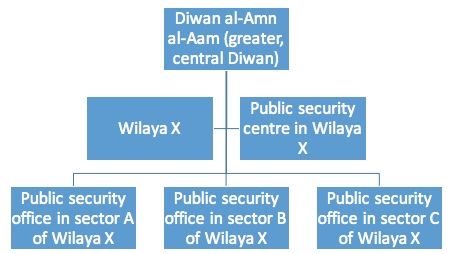
One of the most important questions for any researcher looking into IS is how far there is centralized control of administration and bureaucratic functioning. Is there a system in which central ministries- the greater diwans– exert tight control over the policies, functioning and composition of their provincial and sub-provincial offices, or are the more local institutions more or less left to their own devices in terms of day to day management and appointments of officials and personnel with only some very general policy dictates and guidelines from the central ministries? The concept of decentralization, for instance, has been espoused by Iraqi researcher Hisham al-Hashimi, who told Niqash that “each offshoot of the IS group has a lot of autonomy.”[2] In these documents, an impression of a high degree of autonomy might arise at first sight when one notices that the organizational connection of the amir of the security centre is described as being with the provincial governor. One should compare with a document found in Fallujah that mentions the formation of a number of Diwans (i.e. sub-departments) within the wilaya that should be connected with the wali, his deputy or the general administration official of the province.[3]
Yet the documents under consideration indicate that the central Diwan al-Amn al-Aam decides not only on the general policies, but also the internal system of organization, with which the provincial administration must comply. Further, while the amir of the public security centre in a given province must be mutually agreed upon by the provincial governor and the greater Diwan (with the higher body of the Delegated Committee intervening in the event of a disagreement), the amir of the public security centre cannot simply appoint whosoever he likes for the positions of his deputy, heads of the administrative divisions in the centre and heads of the sectors. The appointments must all be submitted to the greater Diwan for approval (with the position of deputy also being submitted to the provincial governor). Similarly, transfers and removals for these officials cannot be done without the greater Diwan’s approval. The central Diwan can also issue orders for arrest and tracking that the provincial security centre must comply with, and has a right to order for cases (presumably of a much more serious type) to be transferred to it by the provincial security centre. Regular central oversight is another notable aspect of these documents, with the provincial security centre required to submit monthly reports to the greater Diwan. Meanwhile, the provincial administration is barred from redistributing certain equipment handed to the provincial security centre by the greater Diwan, as well as electronic devices in the security centre. In events of military crisis where mobilization of administrative personnel is required, limits are placed on the provincial administration as to the proportion of security personnel that can be mobilized (20%).
In short, going by these documents, it can hardly be said that the greater Diwan adopts a policy of laissez-faire towards provincial and sub-provincial affiliates.
A Ba’athist Hand?
It has become a common theme to attribute the rise of IS since 2010-2011 and its apparent success for a time to the role of former officers from the military and intelligence services of Iraq’s Ba’athist regime.[4] It may thus be tempting to look at the security structures outlined in these documents, be impressed by the apparent sophistication, and then attribute this supposed sophistication to former Ba’athist officer influence. Superficially, one may want to compare the structures with the intelligence services under Saddam Hussein and try to find parallels.
In reality though, this narrative is only intuitive, rather than supported by evidence. The concept of an internal security apparatus is actually well established in jihadist organizations. In its cabinets of ministries declared in 2007 and 2009, IS’ predecessor- the Islamic State of Iraq- counted a public security department among its ministries.[5] In a similar vein, the concept of a security committee features in traditional frameworks for the al-Qa’ida organization, and a security committee was also a part of Ansar al-Islam’s emirate project in Iraq prior to the U.S. invasion in 2003.[6] More recently, Hay’at Tahrir al-Sham, a jihadist entity comprising former al-Qa’ida affiliate Jabhat Fatah al-Sham, reported on its own security apparatus activities through its Iba’ News Agency, documenting a widespread campaign of arrests and crackdowns on IS terrorist cells in Idlib.[7]
Global jihadist organizations, by nature, are always likely to attract the hostility of many if not most nation states, which normally realize that these groups in the long-run intend to overthrow the modern order of nation states. In addition, rivalries can develop between these groups and with other non-state actors. These jihadist organizations, therefore, need to be especially aware of the risk of infiltration and leaking of sensitive information to their enemies. Having a security apparatus is the logical way of addressing this problem. For IS, the imperative to have an effective security apparatus has been all the more paramount on account of the vast U.S.-led international coalition arrayed against it, and the control of large swaths of territory and important population centres spanning the Iraq and Syria borders.
Even so, it is questionable how successful the IS security apparatus has actually been in counter-espionage/counter-intelligence. It is true that there have been no successful internal revolts in IS territories that have driven the group out of areas under its control. Retaking territory from IS has required forces to enter from outside. Yet such a measure of success for IS primarily comes down to IS’ monopoly on force over would-be armed opponents inside the territories it controls, having disarmed many rivals in conquered areas through imposition of repentance programs, and inspiring terror through brutal executions of accused spies and collaborators with the coalition and other enemies, with some cases broadcast in IS propaganda. On another level, IS has not been able to prevent many senior cadres from being killed in raids and airstrikes intended to target the leadership, suggesting a considerable degree of intelligence penetration and leaking of valuable information to the coalition by locals, the very thing counter-espionage is supposed to stop.
Within the documents, one particular department identified as part of a provincial security centre’s structure is the security of the mujahideen administration, intended to track cases of doctrinal corruption. This issue has in fact been a serious problem for IS, particularly on the issue of takfir (declaring someone/something to be of disbelief in Islam) and how widely it should be applied.[8] In the realm of the use of the Internet, no evidence has yet emerged to show that IS was able to develop software and tools to wiretap and monitor communications by civilians over local Internet networks. Instead, the introduction of measures that gradually banned personal Internet connections in people’s homes suggests a reactive approach that fell short of a technological breakthrough.[9]
In light of these considerable failings, the narrative that former Ba’athists were able to create a highly effective security apparatus in IS seems less convincing once examined more closely. Along with the 13 documents found that detail the security structure was a brief document, in the form of a letter from the greater Diwan al-Amn al-Aam to the amir of the security centre Aleppo wilaya, providing notice on a new framework for the security apparatus. The structures detailed in the 13 documents appear to reflect this new framework, notice of which is dated to June 2016. If the framework for the security apparatus had to be revised, the implication is likewise a reactive approach to security problems facing IS, not a highly successful security apparatus to begin with.
The Future
As IS continues to lose territory, the security apparatus structures as detailed are unlikely to persist, as they are intended for a situation of real territorial control and governance. Instead, there will probably be simplification as the organization reverts more and more to insurgent and terrorist tactics.
Limitations
One must bear in mind what these documents do not tell us as much as what they do tell us. For instance, given that there was a change in the security framework in 2016, no documents have yet turned up that can describe the exact changes that took place. We only seem to have the security structure as described in these documents without a detailed comparison with past models. Did the previous frameworks allow for greater autonomy for the provincial security centres, or did the central Diwan have even more powers over the provincial security centres? Can we say with certainty that the framework in the eastern wilayas was/is exactly the same as the western wilayas, despite similarities noted in the security documents that have turned up from Iraq?
Two documents from May 2016 in my raw archives are intelligence reports from the “intelligence division” of the “general [/public] police” addressed to the overall security official of Aleppo province.[10] Do the “general [/public] police” and its intelligence department as detailed in these documents constitute sub-sections of the security offices in the sectors? What exactly is the relation with the “Islamic police” if any? The documents we are examining in this piece do not shed light on this matter.
These are just some questions relating to the limitations of our findings and the documents under consideration that are worth pondering. We should also note that we do not yet have a detailed outline of the internal structure of the greater Diwan al-Amn al-Aam.
In any case, below are the documents translated in full. Any particular comments will be given in the endnotes.
————————————————-
Letter from the Diwan al-Amn al-Aam to the public security centre head in the Aleppo wilaya
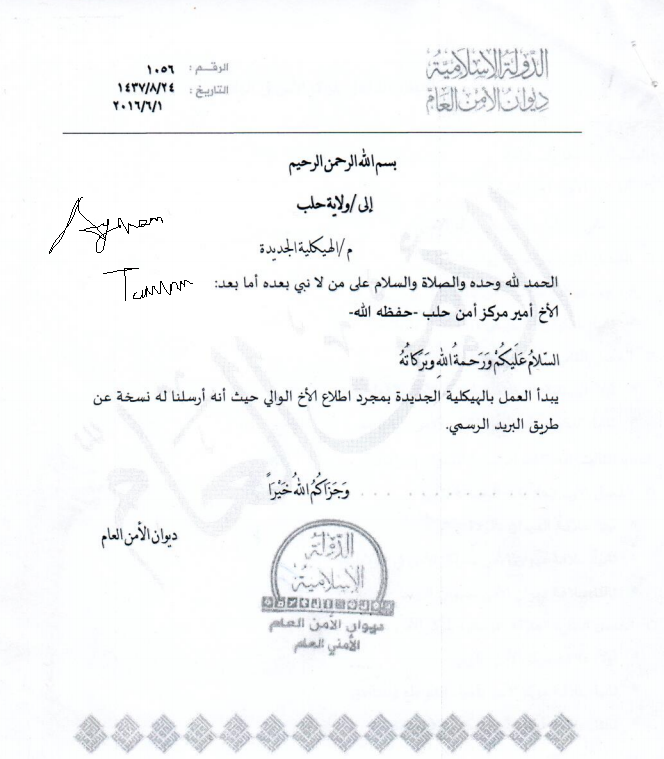
Islamic State
Diwan al-Amn al-Aam
No. 1056
Date: 24 Sha’aban 1436 AH/1 June 2016 CE
In the name of God, the Compassionate, the Merciful
To: Aleppo wilaya
Subject: New framework
Praise be to God alone and prayers and peace be upon the one after whom there is no prophet. As for what follows:
The brother the amir of the Aleppo security centre, may God protect him.
As-salam alaykum wa rahmat Allah wa barakatuhu
Work on the new framework will begin as soon as the wali reviews it as we have sent him a copy through the official post.
May God reward you best.
Diwan al-Amn al-Aam
Islamic State
Diwan al-Amn al-Aam
The public security official
—————————–
Documents outlining the internal system

The internal system for the security centres in the wilayas.
Index:
Chapter One: General definitions
-Section One: Definitions
Chapter Two: The organizational guide to the security centre
-Section One: Security centres in the wilayas
-Firstly: Framework of the security centres in the wilayas
-Secondly: The organizational composition for the security centre in the wilaya
-Section Two: The security offices in the sectors
-Firstly: The organizational framework for the security offices in the sectors
-Secondly: The organizational composition for the security offices in the sectors
Chapter Three: The official relations for the Diwan and its centres
-Section One: The official relations for the Diwan
-Firstly: The Diwan’s relation with the walis
-Secondly: The Diwan al-Amn’s relation with the security centre in the wilayas
-Thirdly: The Diwan al-Amn’s relation with the Diwan al-Jund[11]
-Section Two: The official relation for the security centre with the wilaya
-Firstly: The security centre’s relation with the wali
-Second: The security centre’s relation with the amirs of the sectors and regions
-Thirdly: The security centre’s relation with the repentance office

Chapter One: Definitions
The definition of the following technical expressions in this system is given alongside each one:
. Diwan: Diwan al-Amn in the Islamic State.
. Amir of the Diwan: Amir of the Diwan al-Amn
. Centre of the Diwan: Subdivision of the Diwan in the western wilayas in the Islamic State.
. Organizational unit/Administrative unit: group of personnel who undertake identical and defined assignments that independently appear on the organizational framework and exist at the level of a sector, administration, division, branch, far’ or office etc.
. Administration: organizational administrative unit in the Diwan that may comprise a group of divisions or offices.
. Division: organizational administrative unit in the Diwan affiliated with a higher organizational unit than it: the administration. It may comprise a group of branches.
. Branch: organizational administrative unit in the Diwan affiliated with a higher organizational unit than it: the division.
. Far’: a technical term used to indicate the admin units in their different sizes, either in an independent geographic place or for independent activity.
. Office: small organizational unit in the Diwan established in the fields of administrative, officer or oversight jobs; or it is big and for the large part affiliated with the highest administration.
. Organizational framework: the structure that clarifies the administrative divisions of which the Diwan is composed- organized in the form of levels on top of each other- and the authority and responsibility of every division. And it is the structure through which orders and instructions flow from the higher level to the lower level and in which the competency of taking decisions and the centres of authority and responsibility become clear. Also defined as: the official organizational form for the Diwan, which clarifies how the basic organizational and divisional structure has been put in place and how the job positions relate to the higher, lower and horizontal levels in what serves the implementation of the defined missions.
. Job positions framework: The pyramidal structure for job positions in their identical administrative levels quantitatively and qualitatively from the perspective of the specialities and responsibilities within the one organizational unit. Also defined as follows: representation of the distribution of job positions in the organizational framework apparatus (administration, office, division etc.).
. Job position designation: technical term expressing the purpose of the existence of the job position and it is mostly composed of two words: the first word expresses the fundamental speciality and the second the unit speciality that arises from it like accountant of imports and director of financial administration and amir of the general administration for oversight and inspection.
. System of course of work: outline clarifying how the operation of the official party shows the distribution and connection of its activities to realize the missions and aims for which the organizational unit or administrative apparatus was established.
Chapter Two[12]: Organizational guide to the security centre
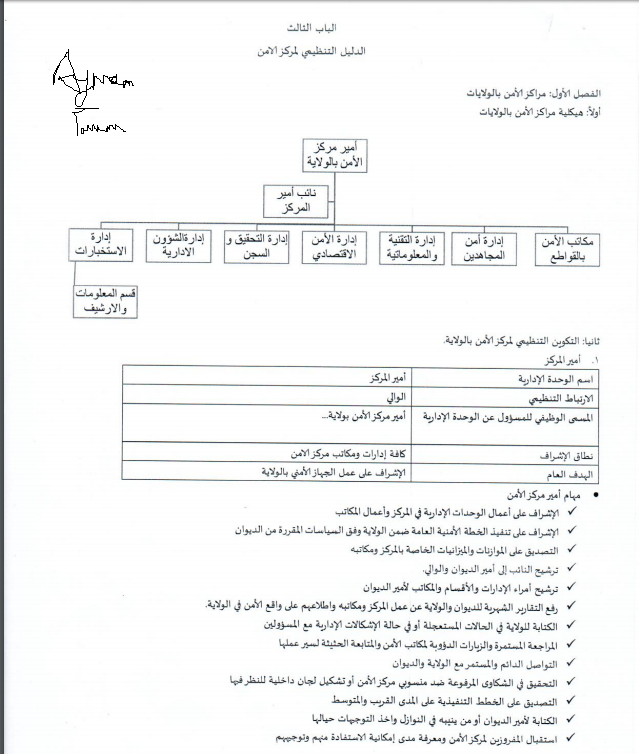
Section One: Security centres in the wilayas
First: Framework of the security centres in the wilayas
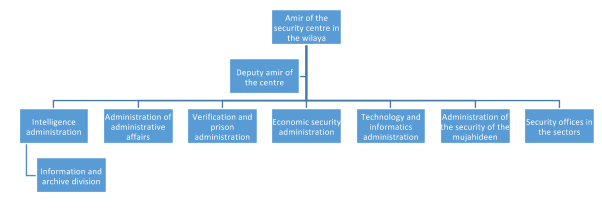
Second: The organizational structure for the security centre in the wilaya:
1. The amir of the centre
| Name of the administrative unit | Amir of the centre |
| Organizational connection | The wali |
| The job position designation for the official of the administrative unit | Amir of the security centre in a wilaya |
| Points of oversight | All administrations and offices of the security centre |
| General aim | Oversight of the work of the security apparatus in the wilaya |
. Tasks of the amir of the security centre
– Oversight of the works of the administrative units in the centres and works of the offices.
– Oversight of implementing the general security plan within the wilaya according to the policies decided by the Diwan.
– Certifying the balances and budgets for the centre and its offices.
– Submitting to the amir of the Diwan and the wali a candidate for the position of deputy [amir of the centre].
– Submitting to the amir of the Diwan candidates for the positions of amirs of the administrations, divisions and offices.
– Referring monthly reports to the Diwan and wilaya concerning the work of the centre and its offices and their review of the security situation in the wilaya.
– Writing to the wilaya in urgent matters or in the event of administrative problems with the officials.
– Continual inspection and persistent visits to the security offices and quick tracking of the course of their work.
– Continual and lasting contact with the wilaya and Diwan.
– Verifying complaints raised against those affiliated with the security centre or forming internal committees to review them.
– Certifying the implementation plans in the short and medium term.
– Writing to the amir of the Diwan or whoso represents him in mishaps and taking up the directives regarding them.
– Receiving those assigned to the security centre and knowing the extent of the possibility of benefiting from them and directing them.
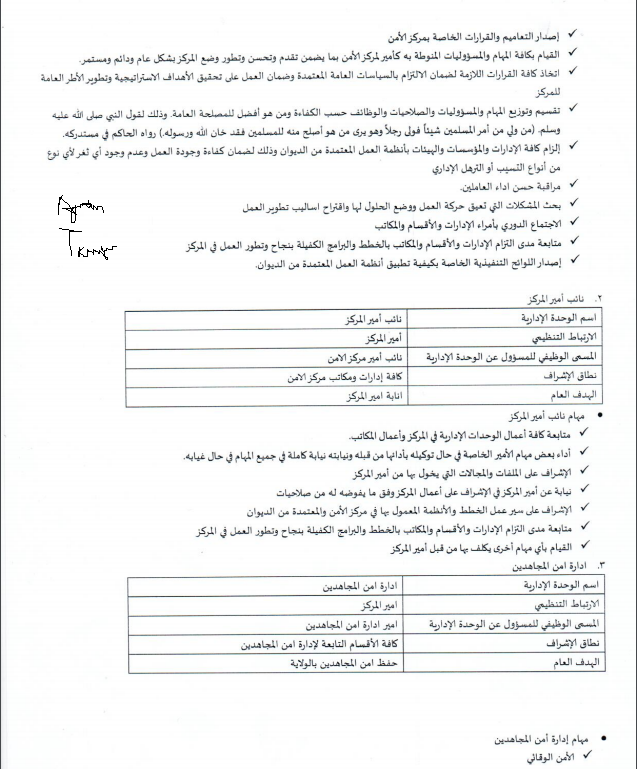
– Issuing statements for distribution and decisions concerning the security centre.
– Undertaking all the tasks and responsibilities entrusted to him as amir of the security centre in what concerns progress, improvement and development of the centre’s situation in a general, lasting and continual sense.
– Taking all the necessary decisions to ensure compliance with the general authorized policies and ensuring work to realize the strategic goals and develop general outlines of action for the centre.
– Dividing and distributing tasks, responsibilities, powers and job positions according to competency and who is more preferable for the general interest, and that is in accordance with the words of the Prophet (SAWS): “Whoso has been entrusted with something from the affairs of the Muslims and has appointed a man even as he sees one who is more competent than him for the Muslims, has betrayed God and His Messenger”- narrated by al-Hakim in his Mustadrik.
– Making all the admins, foundations and committees comply with the systems of work authorized by the Diwan and that is to ensure competent, high quality work and that there should be no trace of any of the types of administrative neglect or flabbiness.
– Oversight of the good performance of the workers.
– Investigating problems that hinder the movement of work and putting in place solutions for them and suggesting methods of developing work.
– Regularly meeting the amirs of the administrations, divisions and offices.
– Tracking the extent of the compliance of the administrations, divisions and offices with the plans and programs ensuring the success and development of the work in the centre.
– Issuing implementation notices regarding how to apply the systems of work authorized by the Diwan.
2. Deputy amir of the centre
| Name of the administrative unit | Deputy amir of the centre |
| Organizational connection | Amir of the centre |
| Job position designation for the official for the administrative unit | Deputy amir of the security centre |
| Points of oversight | All administrations and offices of the security centre |
| General aim | Deputy role of the amir of the centre |
. Tasks of the deputy amir of the centre:
– Tracking all the works of the administration units in the centre and the works of the offices.
– Carrying out some of the special tasks of the amir in the event of being entrusted to do them by him and total representation of him in all tasks in the event of his absence.
– Overseeing the files and fields he is entrusted with by the amir of the centre.
– Representing the amir of the centre in overseeing the works of the centre according to the powers delegated to him by the amir.
– Overseeing the course of work of the plans and systems implemented in the security centre and authorized by the Diwan.
– Tracking the extent of the compliance of the administrations, divisions and offices with the plans and programs ensuring the success and development of the work in the centre.
– Undertaking any other tasks entrusted to him by the amir of the centre.
3. Administration of the security of the mujahideen
| Name of the administrative unit | Administration of the security of the mujahideen |
| Organizational connection | Amir of the centre |
| Job position designation for the official for the admin unit | Amir of the administration of the security of the mujahideen |
| Points of oversight | All divisions affiliated with the administration of the security of the mujahideen |
| General aim | Protecting the security of the mujahideen in the wilaya |
Tasks of the administration of the security of the mujahideen:
– Preventive security
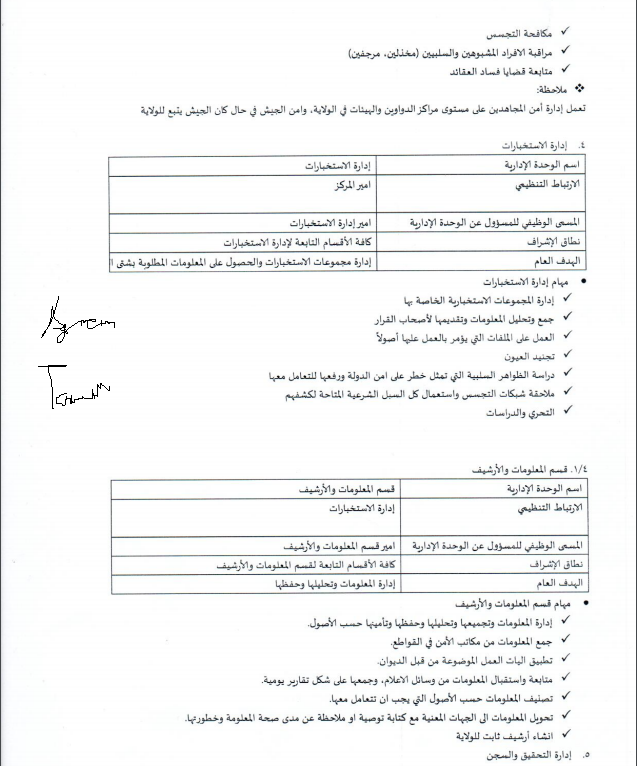
– Counter-espionage
– Monitoring suspect and bad members (disappointingly and agitated)
– Following cases of the corruption of doctrines
Note: the administration of the security of the mujahideen works on the level of the centres of the Diwans and committees in the wilaya, and the security of the army in the event that the army is affiliated with the wilaya.
4. Intelligence administration
| Name of the administrative unit | Intelligence administration |
| Organizational connection | Amir of the centre |
| Job position designation for the official for the admin unit | Amir of the intelligence administration |
| Points of oversight | All divisions affiliated with the intelligence administration |
| General aim | Administration of the intelligence groups and obtaining the desired information in different [types][13] |
. Tasks of the intelligence administration:
– Administration of the intelligence groups in its purview.
– Gathering and analyzing information and submitting it to those with the power of decision-making.
– Working on the files that are ordered to be worked on with due process.
– Studying negative phenomena that represent a danger to the security of the Dawla and referring them to be dealt with.[14]
– Catching espionage networks and using all Shari’i means available to uncover them.
– Investigation and studies.
4/a: Information and archive division
| Name of the administrative unit | Information and archive division |
| Organizational connection | Intelligence administration |
| Job position designation for the official of the administrative unit | Amir of the information and archive division |
| Points of oversight | All divisions affiliated with the information and archive division |
| General aim | Administration of information, analyzing it and preserving it |
Tasks of the information and archive division:
– Administration of information, collecting it, analyzing it, preserving it and securing it in accordance with principles.
– Gathering information from the security offices in the sectors.
– Applying means of work put in place by the Diwan.
– Tracking and receiving information from the media, and bringing it together in the form of daily reports.
– Classifying information according to principles that must be dealt with.
– Transferring information to the relevant parties with the writing of a suggestion or notice concerning the extent of the truth of the piece of information and its danger.
– Establishing a secure archive for the wilaya.
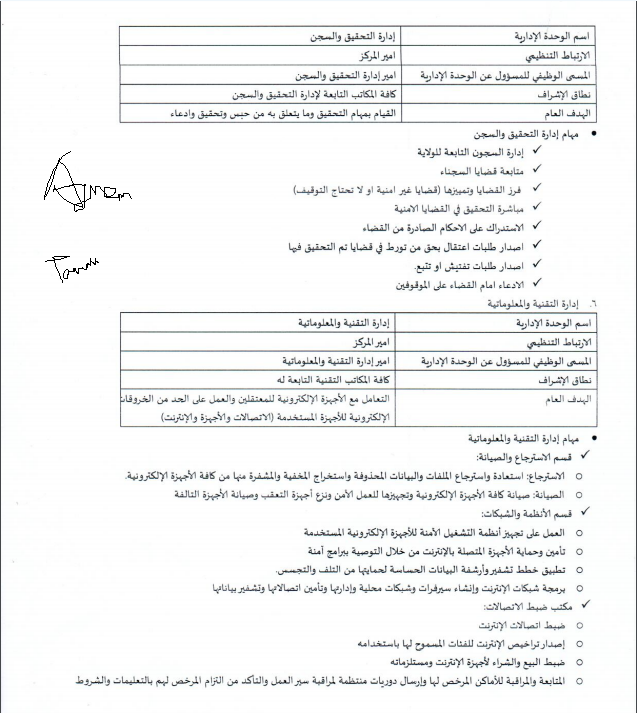
5. Verification and prison administration.
| Name of the administrative unit | Verification and prison administration |
| Organizational connection | Amir of the centre |
| Job position designation for the official for the administrative unit | Amir of the verification and prison administration |
| Points of oversight | All offices affiliated with the verification and prison administration |
| General aim | Undertaking tasks of verification and what concerns it from detention, verification and prosecution |
. Tasks of the verification and prison administration:
– Administration of the prisons affiliated with the wilaya.
– Tracking cases of prisoners.
– Sorting and distinguishing cases (non-security cases or those that don’t need detention).[15]
– Undertaking verification in security cases.
– Supplementing the rulings issued by the judges.
– Issuing arrest requests against whoso has been involved in cases in which verification has been done.
– Issuing requests for inspection and tracking.
– Bringing cases against detainees before judges.
6. Technology and informatics administration
| Name of administrative unit | Technology and informatics administration |
| Organizational connection | Amir of the centre |
| Job position designation for the official of the administrative unit | Amir of the technology and informatics adminiistration |
| Points of oversight | All technology offices affiliated with it |
| General aim | Deal with the electronic devices of detainees and work to stop electronic penetrations for devices that are used (connections, devices and Internet) |
. Tasks of the technology and informatics administration:
– Recovery and maintenance division:
– Recovery: restoring and recovering deleted files and data and extracting the hidden and encrypted from them from all electronic devices.
– Maintenance: maintenance of all electronic devices and preparing them for security work, removing tracking devices[16] and repairing broken apparatuses.
– Systems and networks division:
– Working to prepare safe operating systems for electronic devices that are used.
– Securing and protecting devices connected to the Internet through recommending safe programs.
– Applying plans to encrypt and archive sensitive data to protect them from damage and espionage.
– Programing Internet networks and establishing local servers and networks and managing them and securing their connections and encrypting their data.
– Office to regulate connections:
– Regulating Internet connections.
– Issuing Internet licenses to the parties allowed to use it.[17]
– Regulating the selling and buying of Internet apparatuses and its necessities.
– Tracking and monitoring the licensed places and sending regular patrols to monitor the course of work and make sure those licensed are complying with the instructions and conditions.

7. Economic security administration
| Name of administrative unit | Economic security administration |
| Organizational connection | Amir of the centre |
| Job position designation for the official of the administration unit | Amir of the economic security administration |
| Points of oversight | Economic security administration |
| General aim | Working to preserve economic security |
. Tasks of the economic security administration:
– Verification in relevant cases.
– Investigating cases concerning economic security.
– Assuming responsibility for verifying cases of financial corruption and embezzlement and arresting the accused in those cases or placing them under disposition without arrest.
– Monitoring the financial situations of the soldiers of the Dawla, verifying and gathering information about the reasons for the increase of the wealth of a soldier of the Dawla whether it derives from his presence in the Dawla or not.
– Verifying with the suspect from the soldiers of the Dawla in cases of financial corruption deriving from his work or other actions connected with his work.
– Verifying in cases and problems coming from the areas and sectors and taking the necessary procedures in verification, inspection and controlling those problems and cases found, taking hold of them and arresting the one shown to be involved by evidence.
– Cases of forging currency and precious metals through verifying in them and referring the accused either to the ordinary judiciary or the security one according to the quantity of forgery and its type.
– Cases of smuggling antiquities and rikaz resources[18] of which a fifth part belongs to the Dawla and which issues instructions banning their circulation and excavation without the license of the Dawla.
– Cases of hoarding that impact the economic situation of the land and the Muslims’ livelihood.
– Monitoring strategic commodities in the markets and submitting the necessary suggestions to the authorized parties to take the appropriate measures on the matter of their availability, beginning from encouraging the merchants to make them available, and concluding with the Dawla’s importation of them or intervening in the border crossings to pressure the neighbouring systems to exchange them for other commodities coming out of the lands of the Dawla like necessities of agricultural production from fertilizer, pesticides and other goods.
8. Administration of administrative affairs.
| Name of administrative unit | Administration of administrative affairs |
| Organizational connection | Amir of the centre |
| Job position designation for the official of the administrative unit | Amir of the administration of administrative affairs |
| Points of oversight | All divisions affiliated with the administration |
| General aim | Heeding the administrative and financial needs of the centre |
. Tasks of the administration of administrative affairs:
– Administration of the centre’s capabilities according to principles followed.
– Financial works of the administration.
– Administration of human resources.
– Addressing work needs.
– Undertaking all actions that help the centre’s foundational works.

Section Two: Security offices in the sectors
1. Organizational framework for the security offices in the sectors
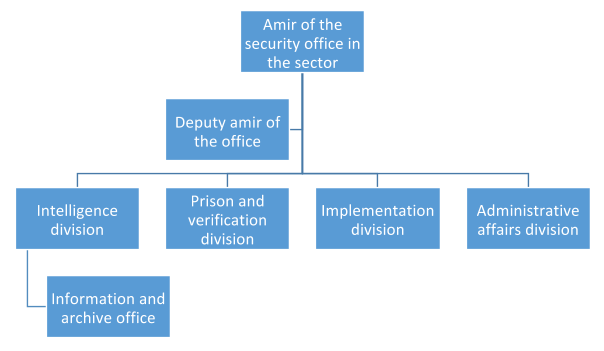
Notes:
1. Some of the offices may have in them a technology and informatics division according to the need defined by the amir of the security centre.
2. Some of the offices will not have in them an implementation division according to the need defined by the amir of the security centre.
Second: organizational structure for the security offices in the centre.
1. Amir of the security office
| Name of the administrative unit | Amir of the security office |
| Organizational connection | Amir of the centre |
| Job position designation for the official for the administrative unit | Amir of the security office |
| Points of oversight | All divisions affiliated with the office |
| General aim | Overseeing the security work in the sector |
Tasks of the amir of the security office:
– Overseeing the works of the administrative units in the office
– Overseeing the implementation of the general security plan within the office and making use of the policies decided by the Diwan.
– Deciding on the budgets and balances concerning the office.
– Nominating the candidate for deputy amir of the security office to the amir of the centre.
– Referring monthly reports to the centre concerning the office’s work and its review of the security situation in the sector.
– Writing to the centre in urgent matters or in event of administrative problems.
– Continual inspection and persistent visits to security personnel and quick tracking of the course of their work.
– Lasting and continual connection with the centre.
– Receiving those assigned to the office and getting to know the extent of the possibility of benefiting from them and directing them.
– Undertaking all the tasks and responsibilities he is entrusted with as amir of the security office in what ensures the progress, improvement and development of the office’s situation generally and in a lasting and continual sense.
– Making all divisions comply with the systems of work set by the Diwan.
– Monitoring the soundness of the workers’ performance.
– Investigating problems that impede the movement of work and putting in place solutions for them and suggesting methods of developing work.
– Regular meetings with the amirs of the divisions and offices
– Tracking the extent of the compliance of the admins, divisions and offices with the plans and programs that ensure the success and development of work in the centre.
– Issuing arrest orders in urgent matters.
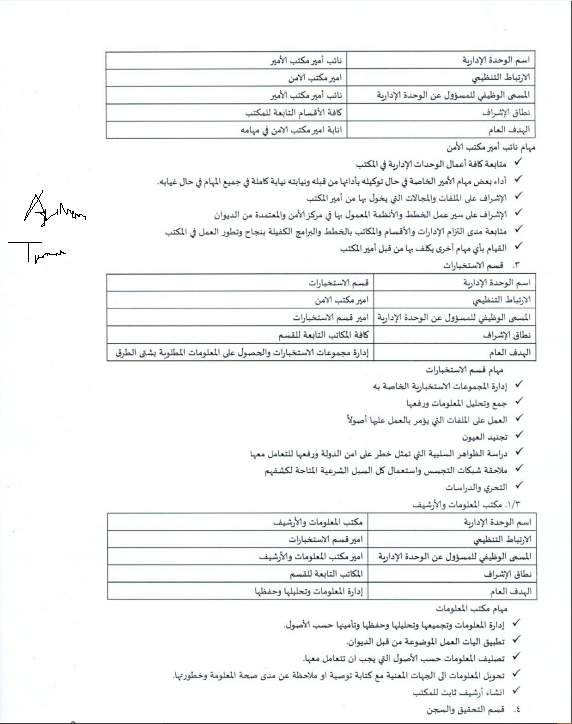
2. Deputy amir of the amir’s office.
| Name of administrative unit | Deputy amir of the amir’s office |
| Organizational connection | Amir of the security office |
| Job position designation for the official for the administrative unit | Deputy amir of the amir’s office |
| Points of oversight | All divisions affiliated with the office |
| General aim | Role of deputy of the amir of the security office in his tasks |
Tasks of the deputy amir of the security office:
– Tracking all works of the administrative units in the office.
– Undertaking some of the amir’s special assignments in the event of being entrusted to undertake them by him and comprehensive representation of him in all missions in the event of his absence.
– Overseeing the files and fields entrusted to him by the amir of the office.
– Overseeing the course of work of the plans and systems implemented in the security centre and authorized by the Diwan.
– Tracking the extent of the compliance of the admins, divisions and offices with the plans and programs ensuring the success and development of work in the office.
– Undertaking any other missions entrusted to him by the amir of the office.
3. Intelligence division
| Name of administrative unit | Intelligence division |
| Organizational connection | Amir of the security office |
| Job position designation for the official for the administrative unit | Amir of the intelligence division |
| Points of oversight | All offices affiliated with the division |
| General aim | Administration of intelligence groups and obtaining the desired information through different means |
Tasks of the intelligence division:
. Administration of the intelligence groups in its purview.
. Gathering, analyzing and referring information.
. Working on files ordered to work on with due process.
. Recruiting eyes.[19]
. Studying negative phenomena that represent a danger to the security of the Dawla and referring them to be dealt with.
. Catching espionage networks and using all available legitimate means to uncover them.
. Inquiry and studies.
3a: Archive and information office
| Name of the administrative unit | Information and archive office |
| Organizational connection | Amir of the intelligence division |
| Job position designation for the official of the administrative unit | Amir of the information and archive office |
| Points of oversight | Offices affiliated with the division |
| General aim | Administration of information, analyzing it and preserving it |
Tasks of the information office
– Admin of information, collecting it, analyzing it, preserving it and securing it according to principles.
– Applying means of work put in place by the Diwan.
– Classifying information according to the principles that must be dealt with.
– Referring information to the specific parties with writing of a suggestion or notice regarding the extent of the truth of the piece of information and its danger.
– Establishing a secure archive for the office.
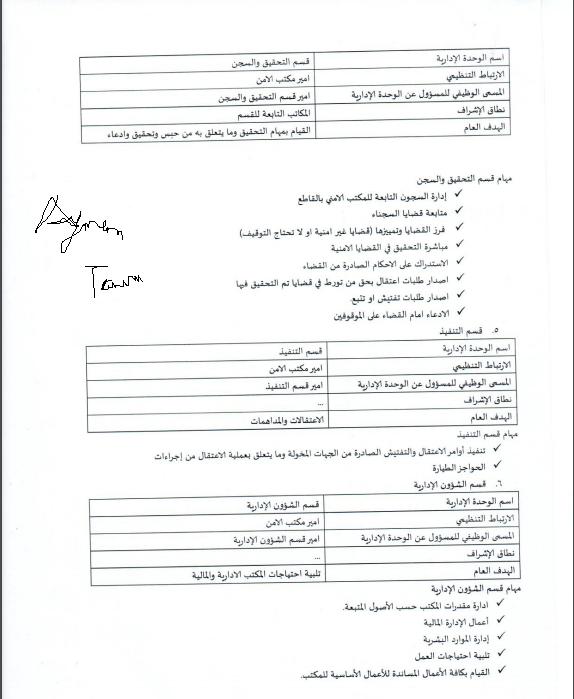
4. Verification and prison division
| Name of administrative unit | Verification and prison division |
| Organizational connection | Amir of the security office |
| Job position designation for the official for the administrative unit | Amir of the verification and prison division |
| Points of oversight | Offices affiliated with the division |
| General aim | Undertaking tasks of verification and things related to it from detention, verification and prosecution |
Tasks of the verification and prison division
– Admin of prisons affiliated with the security office in the sector.
– Tracking cases of prisoners.
– Sorting and distinguishing cases (non-security cases or not requiring detention).
– Undertaking verification in security cases
– Supplementing the rulings issued by the judges
– Issuing arrest requests against those involved in cases in which verification has been done.
– Issuing inspection and tracking requests
– Bringing cases against detainees before judges.
5. Implementation division
| Name of administrative unit | Implementation division |
| Organizational connection | Amir of the security office |
| Job position designation for the official for the administrative unit | Amir of the implementation division |
| Points of oversight | … |
| General aim | Arrests and assaults |
Tasks of the implementation division
– Carrying out the orders of arrest and inspection issued by the authorized parties and what concerns the arrest operation from procedures
– Flying checkpoints.
6. Administrative affairs division
| Name of administrative unit | Administrative affairs division |
| Organizational connection | Amir of the security office |
| Job position designation for the official for the admin unit | Amir of the administrative affairs division |
| Points of oversight | … |
| General aim | Heeding the administrative and financial needs of the office |
Tasks of the administrative affairs division:
– Administration of the office’s capabilities according to principles followed
– Financial administration works
– Administration of human resources
– Heeding work needs
– Undertaking all actions that help the foundational works of the office.
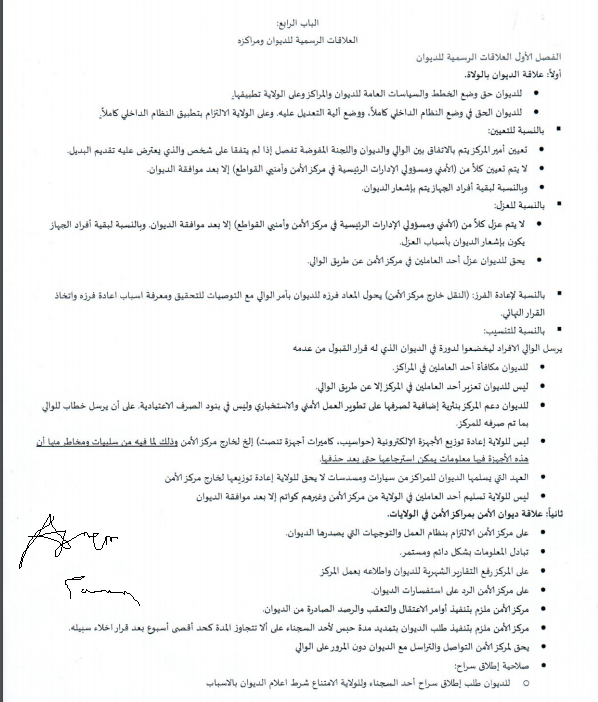
Chapter Three[20]: The official relations for the Diwan
Section One: The official relations for the Diwan
First: The Diwan’s relation with the walis
. The Diwan has the right to put in place the general plans and policies for the Diwan and centres and the wilaya must apply them.
. The Diwan has the right to put in place the internal system in its entirety, and put in place the mechanism for modifying it, and the wilaya must comply with applying the internal system entirely.
With regards to appointment:
. The appointment of the amir of the centre is done by agreement between the wali and the Diwan and the Delegated Committee decides if the two don’t agree on a person and the submission of a replacement is put forth in opposition to that person.
. The appointment of the security official and officials of the main administrations in the security centre and the security officials of the sectors is not to be done except after the agreement of the Diwan.
. Concerning the rest of the personnel of the apparatus, the Diwan is to be notified.
With regards to removal:
. The removal of the security official, officials of the main administrations in the security centre and the security officials of the sectors is not to be done except after the Diwan’s agreement. With regards to the rest of the personnel of the apparatus, the Diwan must be notified of the reasons for removal.
. The Diwan has the right to remove one of the workers in the security centre through the wali.
With regards to reassignment (transferring outside the security centre): the one to be reassigned is to be referred to the Diwan by order of the wali with the recommendations for the purpose of verification and knowing the reasons for reassignment and the adoption of the final decision.
With regards to placement:
The wali is to send the personnel to submit to a course in the Diwan which has the decision to accept or not.
. The Diwan may reward any of the workers in the centres
. The Diwan is not to rebuke any of the workers in the centre except through the wali.
. The Diwan can support the centre through additional cash for it to be spent on developing the security and intelligence work and is not in the usual stipulations of spending, provided that a letter is sent to the wali concerning what has been spent for the centre.
. The wilaya may not redistribute the electronic devices (computers, cameras, eavesdropping devices) etc. to outside the security centre because of the negative consequences and risks from it as the devices may have information in them that can be recovered even after being deleted.
. The wilaya has no right to redistribute to outside the security centre cars and pistols handed by the Diwan to the centre as an entrustment.
. The wilaya may not hand over silencers to any of the workers in the wilaya from the security centre and others besides them except after agreement of the Diwan.
Second: the Diwan al-Amn’s relation with the security centres in the wilayas
. The security centre must comply with the system of work and directions issued by the Diwan.
. Lasting and continual exchange of information.
. The centre must refer monthly reports to the Diwan with its review of the centre’s work.
. The security centre must respond to the Diwan’s inquiries.
. The security centre is obliged to implement the orders of arrest, tracking and observation issued by the Diwan.
. The security centre is obliged to implement the Diwan’s order to extend the period of detention of any of the prisoners so long as the period does not exceed at most a week after the decision to release him.
. The security centre has a right to contact and correspond with the Diwan without going through the wali.
. Power of release:
– The Diwan can request for any of the prisoners to be released but the wilaya may refuse on condition of informing the Diwan of the reasons.
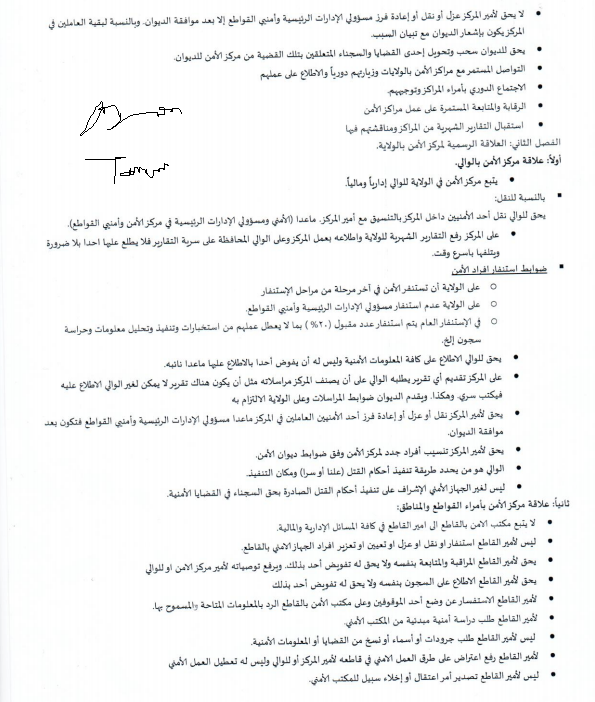
. The amir of the centre does not have the right to remove, transfer or reassign officials of the main administrations and security officials of the sectors except after the agreement of the Diwan, and concerning the rest of the workers in the centre, the Diwan is to be notified with statement of reason.
. The Diwan has the right to withdraw and transfer any of the cases and prisoners detained in that case from the security centre to the Diwan.
. Continual connection with the security centres in the wilayas and visiting them on a regular basis and reviewing their work.
. Regularly meeting with the amirs of the centres and directing them.
. Continual oversight and tracking of the work of the security centres.
. Receiving monthly reports from the centres and discussing with them the reports.
Section Two: The official relation of the security centre with the wilaya
Firstly: The relation of the security centre with the wali:
. The security centre in the wilaya is affiliated with the wali administratively and financially.
With regards to transfer:
The wali has the right to transfer any of the security officials inside the centre in coordination with the amir of the centre, except the security official and officials of the main administrations in the security centre and the security officials of the sectors.
. The centre must refer monthly reports to the wilaya with its review of the centre’s work and the wali must safeguard the secrecy of the reports, so no one else must review them without necessity, and he is to destroy them as soon as possible.
Conditions for mobilizing security personnel:
. The wilaya must mobilize the security in the last stage of the stages of mobilization.
. The wilaya must not mobilize the officials of the main administrations and security officials of the sectors.
. In the event of general mobilization there is to be mobilization of an accepted number (20%) in so far as it does not hinder their work in intelligence, implementation, analyzing information, guarding prisons etc.
. The wali has the right to review all security information but may not delegate anyone to review it except his deputy.
. The centre must submit any report the wali demands provided the centre classifies its correspondences like there is a report that only the wali can review so it writes ‘secret’, and so on. And the Diwan puts forth the regulations of the correspondences and the wilaya must comply with it.
. The amir of the centre has the right to transfer, remove or reassign one of the security officials in the centre except the officials of the main administrations and the security officials of the sectors, which must be done only after the agreement of the Diwan.
. The amir of the centre has the right to affiliate new personnel to the security centre according to the regulations of the Diwan al-Amn.
. The wali is the one who defines the means of implementing rulings of death penalty (publicly or secretly) and the place of implementation.
. Only the security apparatus is to oversee the implementation of the rulings of death penalty issued against prisoners in security cases.
Second: the security centre’s relation with the amirs of the sectors and areas:
. The security office in the sector is not affiliated with the amir of the sector in all administrative and financial issues.
. The amir of the sector is not to mobilize, transfer, remove, appoint or rebuke members of the security apparatus in the sector.
. The amir of the sector has the right to monitor and track by himself and does not have the right to delegate anyone with that, and he is to refer his counsels to the amir of the security centre or the wali.
. The amir of the sector has the right to review the prisons by himself and has no right to delegate anyone with that.
. The amir of the sector may inquire about the situation of one of the detainees and the security office in the sector must respond with the available and allowed information.
. The amir of the sector may request a basic security study from the security office.
. The amir of the sector may not request inventories, names or copies from the cases or security information.
. The amir of the sector may raise opposition to the means of security work in his sector to the amir of the sector or the wali but may not obstruct security work.
. The amir of the sector may not issue an order of arrest or release to the security office.
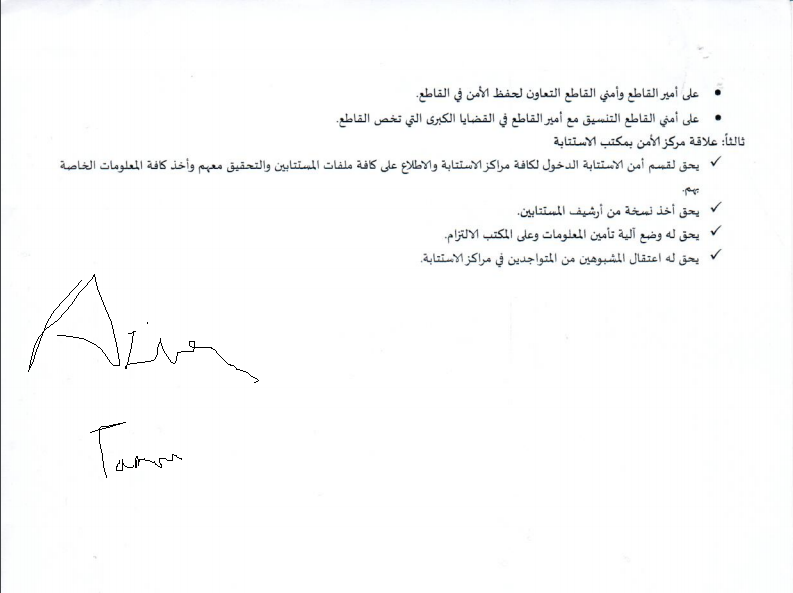
. The amir of the sector and security official of the sector must work together to safeguard the security in the sector.
. The security official of the sector must coordinate with the amir of the sector in the most important cases that concern the sector.
Third: the security centre’s relation with the repentance office
. The repentance security division has the right to enter all repentance centres and review all files of those who repent, verify with them and take all information particular to them.
. There is the right to take a copy of the archive of those who repent.
. It [the security centre] has the right to place a means of securing the information and the office must comply.
. The security centre has the right to arrest suspects from those present in the repentance centres.
Notes
[1] E.g. Aymenn Jawad Al-Tamimi,“Archive of Islamic State Administrative Documents (continued),” aymennjawad.org (Specimens 17J and 18V), January 11, 2016 (https://www.aymennjawad.org/2016/01/archive-of-islamic-state-administrative-documents-1).
[2] “Newsletters Found in Anbar Indicate How Extremist Group Organizes Itself,” Niqash, June 16, 2016 (https://www.niqash.org/en/articles/security/5294/Newsletters-Found-In-Anbar-Indicate-How-Extremist-Group-Organises-Itself.htm).
[3] Aymenn Jawad Al-Tamimi,“Archive of Islamic State Administrative Documents (continued),” aymennjawad.org (Specimen 16W), January 11, 2016 (https://www.aymennjawad.org/2016/01/archive-of-islamic-state-administrative-documents-1).
[4] E.g. Liz Sly, “The hidden hand behind the Islamic State militants? Saddam Hussein’s,” Washington Post, April 4, 2015 (https://www.washingtonpost.com/world/middle_east/the-hidden-hand-behind-the-islamic-state-militants-saddam-husseins/2015/04/04/aa97676c-cc32-11e4-8730-4f473416e759_story.html?utm_term=.c892c1a31f38).
[5] Aymenn Jawad Al-Tamimi, “The Evolution in Islamic State Administration: The Documentary Evidence,” Perspectives on Terrorism, August 5, 2015 (https://www.aymennjawad.org/17687/the-evolution-in-islamic-state-administration).
[6] Aymenn Jawad Al-Tamimi, “A Complete History of Jama’at Ansar al-Islam,” aymennjawad.org, December 15, 2015 (https://www.aymennjawad.org/2015/12/a-complete-history-of-jamaat-ansar-al-islam).
[7] “The security office for Hay’at Tahrir al-Sham arrests a cell comprising 7 members of the Dawla organization in Idlib city, bringing the number of khawarij arrested by the Hay’a today to 32 members,” Iba’ News Agency, July 12, 2017 (https://justpaste.it/iba12july2017).
[8] Bryan Price and Muhammad al-‘Ubaydi, “CTC Perspectives: The Islamic State’s Internal Rifts and Social Media Ban,” CTC, June 21, 2017 (https://ctc.usma.edu/posts/ctc-perspectives-the-islamic-states-internal-rifts-and-social-media-ban).
[9] For a sample of the most recent Internet regulations, see e.g. regulations introduced in the Mosul area in July 2016. Aymenn Jawad Al-Tamimi, “Archive of Islamic State Administrative Documents (continued), aymennjawad.org (Specimens 18V and 18Z), January 11, 2016 (https://www.aymennjawad.org/2016/01/archive-of-islamic-state-administrative-documents-1).
[10] Aymenn Jawad Al-Tamimi, “Archive of Islamic State Administrative Documents (continued…again),” aymennjawad.org (Specimens 32G and 32O), September 17, 2016 (https://www.aymennjawad.org/2016/09/archive-of-islamic-state-administrative-documents-2).
[11] A section by this title does not turn up in the subsequent pages. Appears to be a clumsy error as there is a section on mobilizing personnel, a matter tied of course to the Diwan al-Jund.
[12] Typo in the original has this marked “Chapter Three.” The error has been corrected in the translation.
[13] Typo in the original. “Types” is the additional word meant here. Added in as a correction.
[14] E.g. From other documents I have obtained, in July 2016 the security centre in Aleppo province submitted a report to the greater Diwan. This report constituted a study of some of the Kurdish villages in Aleppo province and the supposed danger they represent to the Islamic State on account of PKK/SDF loyalties among the populations.
[15] E.g. Mere violations of Islamic morality by civilians- such as smoking cigarettes- will not be considered security cases.
[16] E.g. Removing GPS from phones, a measure introduced early on after the declaration of the Caliphate (December 2014). See Aymenn Jawad Al-Tamimi, “Archive of Islamic State Administrative Documents,” aymennjawad.org (Specimen X), January 27, 2015 (https://www.aymennjawad.org/2015/01/archive-of-islamic-state-administrative-documents).
[17] This matter has also been regulated at times by the Diwan al-Hisba.
[18] E.g. Precious metals.
[19] i.e. Recruiting spies.
[20] Original text reads Chapter Four. Typo corrected in the translation.
